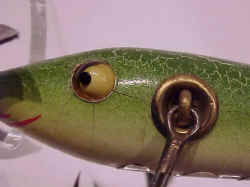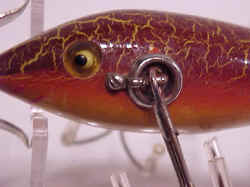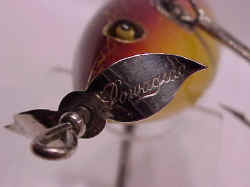|
The pre-1920 Heddon lure and box |
Time Line: Heddon Lure Hardware & Box Identification 1904 to 1930 |
Knowledge for Advanced Collectors of Heddon
Heddon Lure Hardware and Box Identification 1904 to 1930
By Dr. Michael Echols
A flow chart and photos to help you identify the time line when early Heddon lures and boxes were made based on hardware and lure body form.
Heddon early boxes and hardware time line:
1904 (Heddon started use of brass cup rig hardware)
The earliest wood boxes are the Type I and type II, which were used in 1904.
Type III wood boxes were used around 1905, had two belly wt. minnows with brass hardware.
Introduction intro white and picture boxes begin during this time.
1906 (Heddon Double blue line white box, start nickel plated cup rig hardware)
The white box with the double line at the border of the box was in use from 1906 until 1911. Only cup rig, no name on prop lures found in this box.
Type IV wood boxes were in use 1905-6
Type V wood boxes were in used from 1907 until possibly as late as 1910.
1912-1914 (Heddon Down leaping Bass, ‘Name stamped on the spinners’, Name on prop starts 1912, continue Cup rig)
In 1912-13, The Pine Tree, Blue border, and white border boxes were in use for one or two years. Name on prop starts in 1912 with cup rig lures.
The red border down leaping bass box was first used in 1912 to 1915. These boxes will have “stamped on the spinners” on the sides of the boxes and ‘Heddon’s Dowagiac game fish minnow’ on the top.
1914 (Heddon L-rig officially introduced)
1915 (Stamped on the metal, Name on prop, L-rig)
The red border down leaping bass box with ‘stamped on the metal’ and still has ‘Heddon’s Dowagiac game fish minnow’ and in use from 1915 to 1920.
1920 (Folded ends)
The last of the ‘Game fish minnow’ boxes have folded ends, Stamped on the Metal on the sides, is’nt spelled wrong, and were used during 1920 to 1924.
1924 (Genuine Heddon down leaping Bass starts)
The ‘Genuine’ down leaping Bass Heddon Dowagiac minnow red border boxes are from 1924 to 1927.
1927 (Genuine Up leaping Bass appears)
The ‘Genuine’ up leaping Bass started in 1927 until 1930.
Early Heddon lure distinctive features of the hook hardware
The earliest props (Figure 1) are unmarked and consistent with the cup rig hardware. The later post 1912 props are all marked with the words "Heddon" and "Dowagiac" on the prop.
Heddon Hardware
Identifying Heddon lures can be made much easier if you know the types of hardware and the time period they were used.
Cup rig: hardware typical of Heddon baits made prior to 1914. The earliest cups were made of brass and the later were nickel plated. There were variations in the early years with rim anatomy and variations (flat rim cup dates prior to 1907, raised rim cup dates to 1908 and later) detailed in the NFLCC article "Eight Years of Heddon Hardware" by Bill Sonnett.
Note: there are some later cup rigged Heddon lures which are stenciled 'Heddon' on the belly. The body style is slim. The lure was made approximately during 1930-33. Heddon begin putting the stencil 'Heddon' on lures approximately 1927 and somewhere between 1930-33 they used the cup rig again for a VERY short time.


Props: Cup rig underwater minnows can have two types of props: unmarked (No Name On Prop) which dates them prior to 1912; and Name On Prop, which dates them after 1912 when the name Heddon Dowagiac was stamped on the front and rear prop. Heddon made a gradual change to L-rig during the 1914-1915 time range, so it is possible to find NOP lures with cup rig (lures fitting this criteria date from 1912 through 1915-ish) . Apparently they wanted to use up the last cup rig lures and placed the new marked props on the older cup rig lures.
Personal notes from 1991 article on '8 Years of Heddon Hardware' published in the Premier Issue of the NFLCC Magazine: Forward raised cups were used on 100's and 150's until the conversion to L-rig sometime in 1915.
"Killer" props refers to No Name On Prop spinners used on 100,150, 175,300's during 1904 to 1912.
Only the 400 and 450 used 'Killer' props for the whole life time of their production.
In 1912, all lures featured "Dowagiac" on the spinners.
The shift to 'fat body' 100's occurred in 1910.
Long sweeping gill marks on 100's were gone by 1905.
1907 100's can have one large or two belly weights, slim body, low-rimmed hardware, tiny nose washer, and nickel-plated hardware.
The 1911 #100 is a fat body style.
1912 is the year NOP (name on prop) became standard.
L-rig: first cataloged in 1914 on the Dummy Double. . The hook screw has an arm for an attachment screw which comes out of the cup and onto the body. Earliest L-rig is single hump, later two hump L-rig seen after 1914.
Props: Generally only Name On Prop.
Toilet seat: made in two pieces and the toilet seat shape gives it the name. This hardware was in use during 1927 to 1936.
Props: Name On Prop.
Return to AntiqueLures homepage
A FULL TOPICAL INDEX FOR ANTIQUELURES
A LIST OF ALL EARLY FISHING LURES IN THIS COLLECTION












